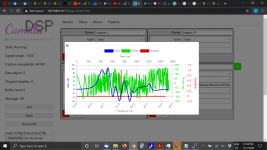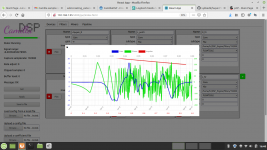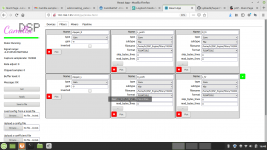New version of pycamilladsp-plot here: Release v0.4.1 * HEnquist/pycamilladsp-plot * GitHub
This fixes the imports of matplotlib so there should be no problems running the gui when it's not available.
This fixes the imports of matplotlib so there should be no problems running the gui when it's not available.
I started looking a little at polyphase filters when I started on the resampler. I actually use a simple form in the asynchronous resampler. But doing more general filtering seems a bit tricky and I would need to do a lot of reading, so I didn't continue along that path. It's interesting though and I would like to dig into it. If I only had more time...
Yes, that time squeeze🙁
Polyphase is part of the multirate litteratur. Fun to see that the same problems that is disqussed in this thread, was also discussed 37 years ago:
Multirate Digital Signal Processing Crochiere-Rabiner - Free Download PDF
No mention of Rust, linux or rpi though

But IIR, FIR, resampling and filtering in detail
Round 1993 i studied MPEG coded music where polyphase filterbanks is the basic component that enables all the datacompression. Here is an nice short description (not by me!):
http://www.eeng.dcu.ie/~ee502/mp3flterbank.pdf
In MPEG filterbanks with "no signal" is often set to zero, still the aliasing is hard to hear.
http://www.eeng.dcu.ie/~ee502/mp3flterbank.pdf
In MPEG filterbanks with "no signal" is often set to zero, still the aliasing is hard to hear.
@Henrik...
The new plotting without numpy is working on my pCP.
My testrig is an RPI3B and it's loaded pretty hard....
The higher the samplerate, the higher load, and i use two filter pr. channel as seen in the plotting... Perfect! 😀
Within the nearest future i will try it on my RPI4B, i think it would be much better.
Most important, it's working!
Jesper.
The new plotting without numpy is working on my pCP.
My testrig is an RPI3B and it's loaded pretty hard....
The higher the samplerate, the higher load, and i use two filter pr. channel as seen in the plotting... Perfect! 😀
Code:
CPU: 26.1% usr 0.9% sys 0.0% nic 72.6% idle 0.0% io 0.0% irq 0.2% sirq
Load average: 1.08 0.63 0.46 3/139 8280
PID PPID USER STAT VSZ %VSZ CPU %CPU COMMAND
8162 1 root S 41160 4.1 3 23.2 /usr/local/bin/camilladsp -p 1234 /home/tc/camilladsp/44100.yml
8142 1 tc S 129m 13.2 1 2.0 /usr/local/bin/python3 /home/tc/webface/Backend-0.5.0/main.py
8161 1 root S 39788 3.9 2 1.8 /usr/local/bin/squeezelite -n Stinout -o - -a 80:4::1: -b 10000 20000 -r 44100 192000 2500 -s 192.168.1.29 -U -U -d output
8278 8179 tc R 3208 0.3 3 0.0 top
9 2 root SW 0 0.0 0 0.0 [ksoftirqd/0]
8276 2 root IW 0 0.0 2 0.0 [kworker/2:1-eve]
8271 2 root IW 0 0.0 1 0.0 [kworker/1:2-eve]
8277 2 root IW 0 0.0 0 0.0 [kworker/0:2-eve]
8160 1 root S 16056 1.6 0 0.0 /usr/local/bin/python3 /usr/local/bin/samplerate-daemon.py
8178 8175 tc S 5076 0.5 0 0.0 sshd: tc@pts/0
8175 1407 root S 5076 0.5 1 0.0 sshd: tc [priv]
1407 1 root S 5076 0.5 3 0.0 /usr/local/sbin/sshd
1 0 root S 3208 0.3 0 0.0 init
819 1 tc S 3208 0.3 0 0.0 -shWithin the nearest future i will try it on my RPI4B, i think it would be much better.
Most important, it's working!
Jesper.
Attachments
Gain after the fir filters😱. I must get used to float.
Can I ask what the length of the filters is?
Can I ask what the length of the filters is?
Hey guy's...
I can't remember detail's about my filters; i created them months ago 🙂
My workflow was.
Taking 4 measurements, around center + center of listning posistion.
AVG them and create EQ with REW (EQ are samplerate independt at this point)
This is the Pre-Filter.
With Pre-filter in convolver (camilladsp), i took 4 more measuremnt's and AVG'ed them.
Those measurement's are then samplerate converted and after that i created new filter's with DRC-fir or DRC-Designer. (As i remember 😕🙂😕🙂)
Therefore i have a chain like this. -The -9dB gain is to avoid clipping.
Jesper.
I can't remember detail's about my filters; i created them months ago 🙂
My workflow was.
Taking 4 measurements, around center + center of listning posistion.
AVG them and create EQ with REW (EQ are samplerate independt at this point)
This is the Pre-Filter.
With Pre-filter in convolver (camilladsp), i took 4 more measuremnt's and AVG'ed them.
Those measurement's are then samplerate converted and after that i created new filter's with DRC-fir or DRC-Designer. (As i remember 😕🙂😕🙂)
Therefore i have a chain like this. -The -9dB gain is to avoid clipping.
Jesper.
I found a few bugs, most important one is that the amplitude axis of the impulse response plot was missing. I also added axis labels.
And I optimized the fft used to plot FIR filters, it's about 4x faster now!
New versions:
Backend:Release v0.5.1 * HEnquist/camillagui-backend * GitHub
pycamilladsp-plot: Release v0.4.2 * HEnquist/pycamilladsp-plot * GitHub
And I optimized the fft used to plot FIR filters, it's about 4x faster now!
New versions:
Backend:Release v0.5.1 * HEnquist/camillagui-backend * GitHub
pycamilladsp-plot: Release v0.4.2 * HEnquist/pycamilladsp-plot * GitHub
@ Henrik:
I just found a silly little remark on the help screen from camilladsp 0.4.0-beta-5 (and previous I supose):
The "usage" line suggests that the "configfile" is mandatory "< >", when it is optional "[ ]" - isn't it..? 😱
should be:
Beta-5 is working great though... 🙂
I just found a silly little remark on the help screen from camilladsp 0.4.0-beta-5 (and previous I supose):
The "usage" line suggests that the "configfile" is mandatory "< >", when it is optional "[ ]" - isn't it..? 😱
Code:
USAGE:
camilladsp [FLAGS] [OPTIONS] [COLOR=darkred]<[/COLOR]configfile[COLOR=DarkRed]>[/COLOR]
Code:
USAGE:
camilladsp [FLAGS] [OPTIONS] [COLOR=darkred][[/COLOR]configfile[COLOR=DarkRed]][/COLOR]The config file is mandatory by default, but can be made optional with the -w flag. I think it's better to keep it the way it is, since it reflects the default.@ Henrik:
I just found a silly little remark on the help screen from camilladsp 0.4.0-beta-5 (and previous I supose):
The "usage" line suggests that the "configfile" is mandatory "< >", when it is optional "[ ]" - isn't it..? 😱
should be:Code:USAGE: camilladsp [FLAGS] [OPTIONS] [COLOR=darkred]<[/COLOR]configfile[COLOR=DarkRed]>[/COLOR]
Beta-5 is working great though... 🙂Code:USAGE: camilladsp [FLAGS] [OPTIONS] [COLOR=darkred][[/COLOR]configfile[COLOR=DarkRed]][/COLOR]
Btw the help screen is autogenerated by the really neat "clap" library which handles parsing of the command line options.
But -9? Does that make sense - in a digital channel containing processing, either a stage clip or not (digitally) - once it time for D/A conversion, it might be a good idea to see that no digital level exceeds -3,2 dB rel all bits being 1's.
Or?
There is no summation in the path where one in the end need to do like 3 (stages) x -3 dB??
I think 🙂
//
Or?
There is no summation in the path where one in the end need to do like 3 (stages) x -3 dB??
I think 🙂
//
Hey guy's...
I can't remember detail's about my filters; i created them months ago 🙂
My workflow was.
Taking 4 measurements, around center + center of listning posistion.
AVG them and create EQ with REW (EQ are samplerate independt at this point)
This is the Pre-Filter.
With Pre-filter in convolver (camilladsp), i took 4 more measuremnt's and AVG'ed them.
Those measurement's are then samplerate converted and after that i created new filter's with DRC-fir or DRC-Designer. (As i remember 😕🙂😕🙂)
Therefore i have a chain like this. -The -9dB gain is to avoid clipping.
Jesper.
His filter has a peak gain of just over +8dB! Check the blue curve in the plot from the gui. Considering that, I don't think -9 is unreasonable 🙂But -9? Does that make sense
//
But I am still lost here... I thought that the -9dB clip gain had to be done before the filters. Or else the clipping has already been done..? Is there "unlimited" amplitude margin as a result of float calculations?His filter has a peak gain of just over +8dB! Check the blue curve in the plot from the gui. Considering that, I don't think -9 is unreasonable 🙂
In some DSP's it does need to be done before because they have hard limits and will clip if you don't. In software it is much easier to leverage the dynamic range of the bit rate and avoid that, if the processing is done at 64 bits then there is 384dB of range which makes inter process clipping almost impossible. But if you don't bring it down afterwards the result will be the same 🙂
In Jesper's case he might actually need -12dB to avoid any oversample peaks.
In Jesper's case he might actually need -12dB to avoid any oversample peaks.

I found a few bugs, most important one is that the amplitude axis of the impulse response plot was missing. I also added axis labels.
And I optimized the fft used to plot FIR filters, it's about 4x faster now!
New versions:
Backend:Release v0.5.1 * HEnquist/camillagui-backend * GitHub
pycamilladsp-plot: Release v0.4.2 * HEnquist/pycamilladsp-plot * GitHub
Excellent! All good now Henrik. Thanks. plotting takes less than seconds now. Filters are 65536 taps I think .dbl format generated by rephase.
Last edited:
In some DSP's it does need to be done before because they have hard limits and will clip if you don't. In software it is much easier to leverage the dynamic range of the bit rate and avoid that, if the processing is done at 64 bits then there is 384dB of range which makes inter process clipping almost impossible. But if you don't bring it down afterwards the result will be the same 🙂
In Jesper's case he might actually need -12dB to avoid any oversample peaks.
So, i shoulden't care moving my -dB gain in the pipeline, to be at front instead of last ?
Thank's fluid!
Jesper.
If it mattered in Camilla you would have heard the difference as digital clipping is difficult to miss.
It's never a bad idea to follow good gain structure and cut before you boost but with a good software DSP you can break all those old rules 🙂
It's never a bad idea to follow good gain structure and cut before you boost but with a good software DSP you can break all those old rules 🙂
But I am still lost here... I thought that the -9dB clip gain had to be done before the filters. Or else the clipping has already been done..? Is there "unlimited" amplitude margin as a result of float calculations?
This make sense too!
Makes me wonder: Where is "0 dB" placed in the floating world?
At -192 (out 384)?
//
- Home
- Source & Line
- PC Based
- CamillaDSP - Cross-platform IIR and FIR engine for crossovers, room correction etc



